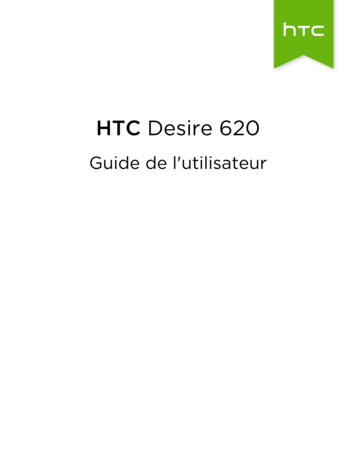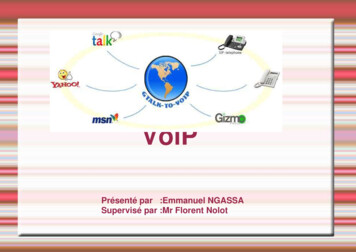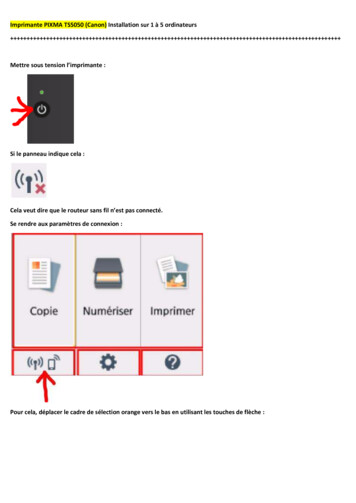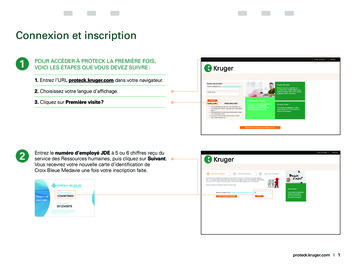
Transcription
p a g e 3 0 MGMA Connexion April 2013 2013 MGMA-ACMPE. All rights reserved.
Quality ManagementDeep dive:What lies beneaththe surface?Reassessing your credentialingprocess could mean more moneyin your practiceBy Scott T. FriesenEffective credentialing processes represent more than gaining approvalfrom payers; they have a direct impacton your revenue cycle and physicianalignment success. Yet many industryprofessionals lack the tools to create effectivecredentialing processes and might not havethe necessary support from industry executives to implement them. A deeper assessmentof what the credentialing process represents —and how it can affect your bottom line — canprovide the right incentives for change.“The problem is that many professionals arein a reactive mode when it comes to credentialing,” says Donna Knapp, MA, FACMPE,independent consultant, MGMA Health CareConsulting Group. “It should be a continuousprocess with dedicated resources.”Industry shifts have prompted more practice managers to recognize the importanceof timely credentialing processes. A growingnumber of people acknowledge that by reducing the credentialing timeframe and obtaining 2013 MGMA-ACMPE. All rights reserved.Provider Identification Numbers (PINs) faster,you are able to bill for claims that wouldotherwise be written off with a slower credentialing process. For example, Medicare doesnot allow you to retroactively bill for claimsunless you have a PIN.Decreasing reimbursement, rapidly increasing costs, health information technology andthe popularity of accountable care organizations (ACOs) have facilitated clinical,operational and financial integration in recentyears. Prior to passage of the Patient Protectionand Affordable Care Act, healthcare organizations (both hospital- and physician-owned)operated almost exclusively on a fee-forservice model, which can be likened to anall-you-can-eat buffet that rewarded providersfor the number of services provided, not theclinical outcome of those services. The rise ofACOs prompted a gradual change in clinical,operational and reimbursement delivery inwhich some providers are reimbursed for the››MGMA Connexion April 2013 p a g e 3 1
››quality and successful clinical outcomes oftheir efforts.As a result, hospitals and physician groupshave begun to align in various forms of ACOsor integrated delivery networks to facilitate theshift to a fee-for-quality model that includesquality and clinical outcomes. For example,Kaiser Permanente, Mayo Clinic and Geisenger have had success with their fee-for-qualityreimbursement models, which many largehealth systems are trying to emulate, according to industry experts.Analytics allow administrators to take the anecdoteout of physician credentialing and compile statisticaland financial data that can be used to provideincentives for physician adherence.The ability to optimize the credentialingprocess with operational and financial metricsis an essential component to this success. Forexample, data can be used to assess the daysin enrollment (DIE) calculation for delegatedand non-delegated payers. The ability to linkgross charges to in-process credentialing applications, workflow tools, robust reporting,and analytics will facilitate physician alignment strategies, improve productivity, reducecredentialing timeframes and generate incremental revenue for healthcare organizations.“Physician and allied health provider credentialing requirements have been overlookedby most hospitals and physician organizations,” says Pam D’Apuzzo, president, RRHealth Strategies, a consulting group thatspecializes in physician practice management,coding and compliance. “This has led theOIG [Office of Inspector General] to scrutinize incident-to services. Organizations canmitigate their risk by using robust software tocredential and bill for their services in a compliant manner.”The number of hospital professionals whohave initiated efforts to acquire and/ormerge with other hospitals and physicianorganizations to reduce costs and improveclinical outcomes is on the rise, according topublished reports. Hospital mergers and acquisitions activity increased 33 percent in 2010p a g e 3 2 MGMA Connexion April 2013from 2009, according to Healthcare FinanceNews.1 Drilling down, 980 healthcare mergerand acquisition deals valued at 227.4 billion took place in 2011, according to ModernHealthcare.2 And many of those deals includedphysician medical groups.Although we are seeing an increased interestin physician practice and hospital integration,history shows that some executives mightnot understand the operational and financialimplications of setting up the robust billing,credentialing systems and operations requiredto successfully execute a physician-alignmentstrategy. As a result, many hospital professionals are seeing an increase in physician-relateddenials, frustrated doctors and lost revenue.For example, many see that credentialingdenials are not easily reversed by payers andrepresent a loss of valuable revenue.CredentialingCredentialing requirements and challengeshave been part of healthcare operationsfor decades, but market pressures have emphasized the need for efficient programs tocapture available revenue and ensure workforce efficiencies. A dramatic increase inphysician onboarding efforts and regulatorycomplexities from health plans and credentialing locations (for example, cross-credentialingproviders at multiple or all locations) haveforced professionals to seek workforce efficiencies, such as reducing administrative denials tocollect all revenue.“Having a robust workflow and analyticssoftware solution that is tied to key performance metrics ensures that we are proactivelymanaging our credentialing process,” saysMotti Edelstein, director of managed care atNorth Shore – LIJ Health System, N.Y. Thosemetrics include provider-related denials, “collecting every dollar owed to our organizationand ensuring that we are adequately staffed tohandle provider growth,” he adds.The state of credentialing software is a primeexample of an industry failure to connect thecredentialing and revenue cycles. In the late1990s, software companies developed productsthat reduced the data-entry time needed to credential a physician by allowing doctors to createa database of physician demographic data and 2013 MGMA-ACMPE. All rights reserved.
Quality Managementauto-populate applications from the same database. This reduced the processing time to submitall applications from approximately 40 hours tofour hours. However, these products do not showhow credentialing affects the revenue cycle.More than paperworkHealthcare professionals need to understandthe different segments of the credentialing lifecycle to gain perspective on the larger operational and financial processes. They include: Human resources (HR) Hospital credentialing/privileging Physician credentialing Revenue cycleIf healthcare professionals fail to view thecredentialing life cycle as an integral component of the revenue cycle, they will seeincreased denials, frustrated physicians, fragmented operations and lost revenue. Ideally,physician credentialing will be considered inthe following light: It is an integral component of the revenuecycle, not a separate and siloed department. It is one of the first steps in the revenuecycle and considered a continuous process.Physician credentialing should be alignedwith the HR and hospital credentialing process in these ways:HR works closely with the hospital andphysician credentialing departments to set astart date, integrate the hiring, privileging andphysician credentialing process into oneseamless process.After a physician is hired, HR shares thenews with the hospital credentialing department to initiate primary-source verificationservices.Working concurrently, HR and credentialing department personnel tell the medicalprivileging committees/boards how manyphysicians will be up for review and privileging approval. If there are multiple medicalprivileging committees/boards in your organization, inform them in advance. Considerincreasing the frequency of committees/board meetings. Every day that passes withoutprivileges means that physicians cannot seepatients to generate revenue. 2013 MGMA-ACMPE. All rights reserved.After a physician is hired and the medical privileging committee/board review isunderway, HR and hospital credentialingdepartment personnel ask the physiciancredentialing department to begin the datacollection process. Collect as much demographic information and primary-sourcedocumentation as early as possible becausethere is significant overlap with the datathese groups need to conduct their respective jobs. By leveraging HR and credentialingdepartment data collection efforts, physician credentialing department personnel canprepare all credentialing documentation inadvance and have enrollment applicationsready for submission to payers once aphysician is granted privileges.Incorporate revenue-cycle concepts intophysician credentialing to identify revenueloss and incremental revenue opportunities.Physicians are often granted privileges to practice at hospitals before they are enrolled withIf healthcare professionals fail to view the physiciancredentialing life cycle as an integral component of therevenue cycle, they will see increased denials, frustratedphysicians, fragmented operations and lost revenue.an organization’s insurance payer. Althoughthis might fill the need for a specialist’sservices, there is a negative revenue impactfor the organization. For example, a physicianstarts seeing patients June 1 but has not beenenrolled with the 20 insurance payers by thephysician credentialing department. This physician generates gross charges of 5,000 in oneday and 400,000 in gross charges over thecourse of 120 days. Now apply that scenario to10 physicians and the total gross charges during that 120-day period is 4 million. Keep inmind that the physician credentialing department takes at least 120 days (four months) toobtain a PIN for all 20 insurance payers.If the organization’s gross collection rate is30 percent, the expected net cash translatesinto 1.2 million. However, many insurance payers do not retroactively reimbursefor services conducted without a PIN, so the››MGMA Connexion April 2013 p a g e 3 3
››organization is faced with a 1.2 millionwrite-off. If 50 percent of insurance payersretroactively reimburse, this still translates to a 600,000 write-off.Create robust metrics to identify, track,trend and manage the physician credentialing life cycle. The following metrics should beconsidered standard practice in any physiciancredentialing department: Total physician credentialing opportunity:Total physicians x total payers x totallocations* Total opportunity Total participating status: Total PINs / totalopportunity Total non-participating status: Total nonparticipating statuses / total opportunity Total in-process status: Applications inthe process of being granted PINs / totalopportunity Total financial impact of in-process applications: What is my gross charge impact, whatis my net cash impact, how do my in-processapplications affect my cash on hand,accounts receivable (A/R), etc.? DIE — non-delegated payers: Total numberof elapsed days from the time an application was submitted to an insurance payercompared with a standardized non-delegatedmetric (90 to 120 days). DIE - Delegated payers: Total number ofelapsed days from the time an application was submitted to an insurance payercompared with a standardized delegatedmetric (30 to 45 days).Use physician credentialing workflow toolssimilar to those used in A/R and revenuecycle management to reduce credentialingtimeframes, increase productivity and generate more cash. Recommendations for thisdepartment: Create dynamic work lists that focus on thephysicians and payers who generate the mostrevenue. This approach might be controversial for multispecialty groups but can helpmaximize the 80/20 rule and ensure that themajority of top-performers are fully enrolled. Establish productivity tools to gauge credentialing specialist activities and ensure theseactivities are geared toward PIN completion. Develop productivity benchmarks andbaselines to improve overall productivity.Industrywide productivity metrics do notexist for physician credentialing.Physician credentialing needs robust reporting and analytics to better understand howdepartments are performing, identify processbreakdowns and implement corrective actions.Robust and easy-to-use reporting andanalytic tools allow healthcare professionalsto understand how their credentialing departments are performing. Most credentialingsoftware companies provide limited reporting*Some payers require location PINs, others require one PIN for multiple locations. It depends on yourpayer and the state in which you practice.Hospital credentialing:The process for hospital professionals to review aphysician’s education, licensure, training, certifications, work and malpractice history to ensure thatthe physician to whom they are granting privilegeswill safely and securely provide patient services. Theindustry has developed strict hospital credentialingstandards to ensure uniformity across all hospitals.p a g e 3 4 MGMA Connexion April 2013 2013 MGMA-ACMPE. All rights reserved.
Quality Managementbut do not link charges to in-process applications or DIE calculations that highlight payerperformance.Robust data analysis tools must be usedduring the physician credentialing life cycle sothat professionals can see how their credentialing departments are performing.When an operational process breakdown isidentified, immediate corrective action shouldoccur. For example, a credentialing department will compile a credentialing applicationand give it to a physician for signature in ashort period of time. However, occasionally aphysician is late returning the signed application. This delay, while inconsequential tothe physician, has a real and direct revenueimpact for the organization. By tracking andtrending this process in the credentialinglife cycle, the department can tell the physician how the delay affects the overall bottomline. When you identify a financial processbreakdown, implement immediate corrective action. If a physician is delinquent inproviding a signed signature page to the credentialing department but generates 5,000of gross charges on a daily basis, analytics canidentify the financial impact of that delinquency, which could prompt the physician toreturn the page sooner.Analytics allow administrators to take theanecdote out of physician credentialing andcompile statistical and financial data that canbe used to provide incentives for physicianadherence. Robust analytics can also be usedwith payers. Healthcare professionals canshow specific examples of when payers havebeen delinquent in processing their physician credentialing applications. For example,healthcare professionals can identify howlong it takes each payer to credential theirphysicians. If payers are taking longer thancontractually obligated, show how the behavior affects your bottom line and use the datato negotiate better credentialing guaranteesand/or contracted rates.“Credentialing software can also help youidentify breach of contract,” Knapp adds. “Idon’t think people use this enough to keeppayers honest with what they’ve told us theywill do.”As the healthcare environment shifts andchanges, professionals must understand that iftheir physicians are not credentialed correctly,groups will not be paid correctly, and physicians will not be fully integrated with theirhealthcare organizations. The implementationof a clearly defined physician credentialinglife cycle that encompasses physician credentialing metrics, workflow tools and robustreporting will result in a seamless hospital/physician alignment strategy and increasednet revenue.Notes:1Healthcare Finance News – Hospital M&A ActivityJumped 33 Percent is 2010 - y-jumped-33-percent-20102Modern Healthcare – M&A Activity Stayed Strongin 2011, Levin Says - sician credentialing (also known as provider enrollment):The process to credential a physician and/or allied health provider with a particular insurance payer to receivereimbursement for services rendered. Physicians and allied health providers are required to fill out credentialingapplications that can be 30 to 50 pages long to obtain a Physician Identification Number (PIN) and receive payment from Medicare, Medicaid, commercial or managed care insurance payers. Some statistics show that a singlephysician submits 20 to 25 individual enrollment applications annually and spends up to 40 hours annually tomanage these credentialing requirements. To provide perspective: There are more than 1.4 million physicians andnonphysician providers who need enrollment and reenrollment management, and the national average enrollment per physician or allied health provider is 20 to 25 insurance payers. 2013 MGMA-ACMPE. All rights reserved.MGMA Connexion April 2013 p a g e 3 5
The state of credentialing software is a prime example of an industry failure to connect the credentialing and revenue cycles. In the late 1990s, software companies developed products that reduced the data-entry time needed to cre-dential a physician by allowing doctors to create a database of physician demographic data and ››










